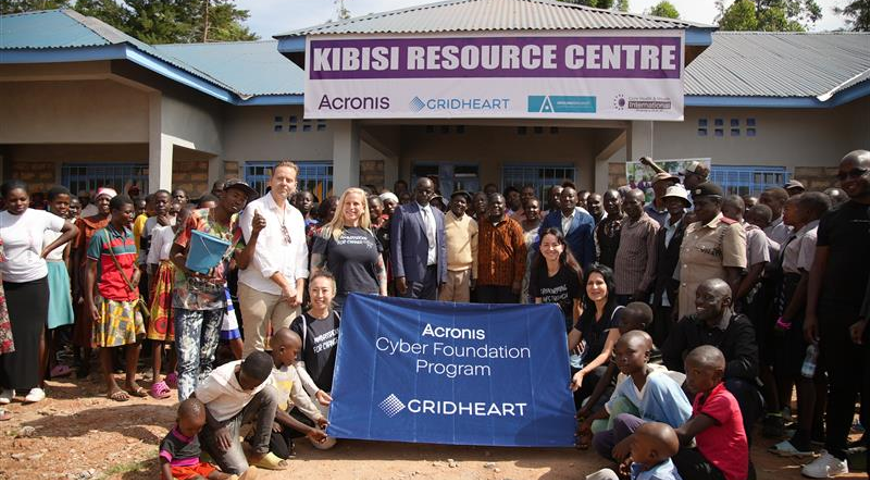
Women don’t experience working in technology the way men think they do. A new global survey from Acronis reveals that there is wide perception gap between genders about the roles of men and women in the tech industry.
The Acronis 2025 Women in Tech report, "FOMO at work: The opportunity gap between men and women in tech," reveals a notable disconnect between how women experience their careers in IT and how their male colleagues perceive women’s experiences.
What makes this survey unique is that it’s not just women answering questions about their own careers. It’s also men answering questions about women’s careers. Acronis surveyed more than 650 people in eight countries about a variety gender-related issues. More than 70% of respondents were men, which closely tracks to the gender breakdown of employees in the IT industry.

The gender perception gap: Lots of differences but some agreement
The differences between how women see their presence in the technology industry and how men perceive women in technology can be striking. Still, some of the responses run counter to what most observers might expect.
Differing views of equal opportunity
Ask men and women whether career opportunities are equal in tech, and you'll get two very different answers. Three-quarters of men believe men and women have equal access to career development opportunities. Among women, only 60% agree.
This 15-percentage-point gap represents a fundamental disconnect in workplace perception. While 37% of women say career opportunities are simply not equal, only 24% of men share that view.
The work-life balance divide
One of the most noticeable gender perception gaps revealed itself on the subject of work-life balance. When asked whether work-life balance challenges significantly or extremely impact women's career progression, 63% of women said yes. Only 49% of men agreed.
The numbers go on to tell a deeper story. While nearly half of men believe work-life balance issues affect everyone equally, women aren’t so sure: 42% of women say work-life challenges disproportionately affect women, while only 34% of men agree.
And when it comes to working long hours to get ahead, 66% of women believe they must put in extra time to advance their careers, while only 56% of men think women face that kind of pressure.
Gender bias: A barrier for women in tech, but how big?
Gender bias and stereotypes emerged as the top barrier preventing women from pursuing cybersecurity careers, but women identified them as a problem more frequently than men did: 41% of women cited bias and stereotypes as the main discouragement factor, compared to 33% of men.
The pattern repeats when it comes to leadership. When asked about barriers to women pursuing leadership roles in tech, 41% of women pointed to gender stereotypes and bias, while 36% of men agreed.
What women want: Advocacy over mentorship
When it comes to support from male colleagues, women have clear preferences: 43% of women want men to advocate for equal opportunities for women. Only 17% of women prioritized mentorship from men.
However, 23% of men believed mentorship and sponsorship was the best way to support female colleagues, while only 35% chose advocacy. Women want male allies who will use their influence to create change and not just advisors who offer guidance.
The leadership opportunity
There's one area where both genders generally agree: Increasing women in leadership would positively impact the tech industry. A large majority of women, 82% agree with that sentiment, and so do 74% of men. However, women were more likely to describe the potential impact as "very positive" rather than just "somewhat positive."
Why gender perception gaps matter
The differences revealed in this survey aren't trivial. When men and women see women's career experiences so differently, addressing real barriers can become a challenge. Closing the gender gap in tech requires first closing the perception gap about what women experience.
Download the full report for more survey responses and a broader perspective on the gender perception gap.
Combined statistics: How responses from men and women look together
Responses by gender reveal a lot about how women and men perceive each other’s careers differently as well as about how they believe organizations can achieve gender equity. But what do the numbers look like when everybody’s responses are put together? (For the purposes of this survey, only respondents who identified as male or female are counted in gender-specific numbers. Those who identified otherwise are included in combines statistics.)
Barriers to opportunities for women remain entrenched
When examining why women might be discouraged from pursuing cybersecurity careers, 35% of all respondents cited gender bias and stereotypes as the main reason. This finding cuts across gender lines, suggesting broad recognition that bias remains a primary barrier to women's participation in IT. Other significant factors included limited exposure to cybersecurity careers and lack of mentorship opportunities.
Other barriers actively limit advancement for women who are already in IT. The survey revealed that 38% of respondents identified gender stereotypes or bias as the biggest barrier to women reaching leadership positions, followed closely by work-life balance challenges at 32%. When leadership roles are less accessible for women, a self-reinforcing cycle of underrepresentation develops at senior levels.
A particularly telling statistic emerged when examining actual career decisions: 41% of respondents reported that they have considered or turned down leadership opportunities specifically due to work-life balance concerns. That not insignificant number reveals how work-life balance issues can actively prevent qualified professionals from advancing in their careers.
FOMO as a daily reality in IT careers
Survey results reveal that FOMO isn't just occasional anxiety. It's a persistent source of career concern affecting the majority of IT professionals regardless of gender.
The numbers paint a clear picture of widespread career anxiety related to missing opportunities:
- 43% sometimes feel they're missing out on important career moments due to family responsibilities.
- 17% frequently feel left out of major opportunities.
- 11% often compare themselves to peers without family responsibilities.
- 7% regularly feel anxious about falling behind in their careers.
These statistics demonstrate that FOMO has moved beyond a vague concept to become a measurable impediment to career progression, particularly for those balancing professional ambitions with family life.
The real cost of career sacrifices
The impact of FOMO becomes concrete when examining actual career decisions. Nearly half of all respondents (48%) have turned down promotions, training, or additional responsibilities due to work-life balance concerns. Breaking this down further, 18% have declined multiple opportunities while 30% have passed on at least one significant chance for advancement.
Even more striking, 73% of IT workers have declined work-related opportunities such as conferences, business trips and networking events at least once due to family obligations. These missed opportunities hinder professional development, networking and long-term career advancement.
Work-life balance: A critical career bottleneck
The combined results reinforce that work-life balance challenges create significant barriers to career progression,. A substantial majority of respondents (63%) believe the tech industry has a work-life balance issue that disproportionately affects women, while 42% rated work-life balance challenges as a 4 or 5 out of 5 in terms of career impact.
Those aren't just abstract concerns. They can translate directly into career limitations. Over one-third of respondents have declined promotions, training or work travel due to family obligations. This pattern creates a compounding effect where those most affected by work-life balance challenges systematically miss the experiences and opportunities that lead to career advancement.
The tech industry's culture of long hours, on-call availability and extensive travel requirements creates particular challenges for professionals managing family responsibilities. Without fundamental changes, those cultural norms will continue to create barriers for substantial portions of the IT workforce.
Organizational gaps: Recognition without implementation
The survey reveals both encouraging recognition of the value of gender diversity and concerning shortfalls in organizational commitment to meaningful change.
A strong majority of respondents acknowledge that gender diversity positively impacts key organizational outcomes. However, when rating actual organizational efforts, the results are far less encouraging. Many respondents rated their company only 3 out of 5 on diversity commitment.
Only 37% believe their organization is proactive in promoting gender equality in leadership, while 46% characterize efforts as “somewhat, but more can be done.” This suggests that while organizations talk about diversity, many fall short when implementing meaningful change.
The gap between recognition and action represents perhaps the most significant opportunity for improvement.
Regional perspectives: Cultural variations in gender challenges
The expanded geographic scope of this year's survey reveals fascinating cultural and regional differences in how IT professionals perceive gender issues. These variations highlight how regional workplace culture and policy shape women's experiences in technology careers.
European focus on bias recognition
European respondents showed particularly strong awareness of gender bias as a barrier to women's participation in IT. The United Kingdom stands out most dramatically, with 46% of respondents citing gender bias and stereotypes as the primary reason women are discouraged from cybersecurity careers. This compares to 33% in the United States, 29% in Spain and 26% in Switzerland.
France presents a split perspective, with responses evenly divided between gender bias and stereotypes (33%), and lack of female role models (33%). Germany emphasizes both gender bias (33%) and limited exposure to careers for women (31%).
Work-life balance: Dramatic cultural divides
Perhaps the most striking regional differences emerge around work-life balance, revealing vastly different cultural attitudes toward gender roles and workplace expectations. The United States stands out as viewing work-life balance challenges as particularly difficult for women, with 54% of U.S. respondents saying those challenges disproportionately affect women. That’s the highest rate among all countries in the survey.
The American response contrasts sharply with European perspectives. In Germany, only 17% agree that work-life balance disproportionately affects women. Switzerland shows a similar pattern, with only 26% viewing balance challenges as women-specific.
The practical implications of these cultural differences become clear when examining declined opportunities. The United States reports the highest rate globally, with 82% of respondents having declined work-related opportunities due to family obligations. This compares to 70% in the United Kingdom, and 73-74% across Switzerland, Germany, and Spain. Asia-Pacific countries like Singapore and Japan report declining opportunities less frequently.
Access to equal opportunities: Confidence variations
Confidence in equal access to career development opportunities varies significantly by region. Switzerland and the United States show the highest confidence levels, with 76% and 75% respectively believing men and women have equal access to career development opportunities.
Spain presents the most skeptical view, with only 60% expressing confidence in equal access. Germany shows mixed results, with 39% saying access is “mostly” equal but a significant 31% responding “not really.”

About Acronis
A Swiss company founded in Singapore in 2003, Acronis has 15 offices worldwide and employees in 50+ countries. Acronis Cyber Protect Cloud is available in 26 languages in 150 countries and is used by over 21,000 service providers to protect over 750,000 businesses.



